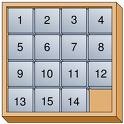Given the gorgeous touch screen it has, the iPhone is destined to be used for sliding block puzzles. Edward Hordern, the grandmaster of sliding block puzzles defined these kind of puzzles as follows:
“A sliding block puzzle consists of a group of pieces of any shape(s) enclosed within a confined area, in which the purpose is to rearrange the pieces either into a certain order or to get a particular piece to a specified position. This is accomplished by sliding the pieces or “blocks” —hence the name sliding block puzzles — usually one at a time into areas not occupied by other pieces. The lifting of pieces is never allowed — nor must they hop or jump over other pieces.”
Edward Hordern’s classic 1986 volume on these puzzles ‘Sliding Piece Puzzles’ is unfortunately long out of print, but a selection of the wide array of puzzles that have been develop in this realm can be found on Nick Baxter’s Sliding block page on PuzzleWorld and Rob Stegmann’s Sliding Block page.
It all started with the infamous 15 puzzle. This puzzle consists of fifteen 1×1 square blocks on a 4×4 grid that can be moved around, because one square is left empty. The original goal of the puzzle was to exchange the blocks ’14’ and ’15’ just by sliding the blocks (which is actually impossible). This puzzle becomes a craze in the US between january and may 1880, and from april 1880 onward appearing in Europe. It is often claimed that the puzzle was invented by Sam Lloyd, but this is a myth. For an in-depth historical analysis of the development of the 15-puzzle, see the fabulous Book by Jerry Slocum and Dic Sonneveld.
 The really interesting part of this puzzle is that fact that it is impossible to exchange two blocks. This is not immediately obvious, so one might be tempted to just slide the blocks around and try to find the solution. Unfortunately, this aspect of the puzzle is completely lost on almost all contemporary incarnations of the simple 1×1 sliding block puzzles. They simple consist of a scrambled situation which can be solved, it just is somewhat tedious to do so. Such puzzles are found everywhere, in various sized and often with nice pictures on the blocks.
The really interesting part of this puzzle is that fact that it is impossible to exchange two blocks. This is not immediately obvious, so one might be tempted to just slide the blocks around and try to find the solution. Unfortunately, this aspect of the puzzle is completely lost on almost all contemporary incarnations of the simple 1×1 sliding block puzzles. They simple consist of a scrambled situation which can be solved, it just is somewhat tedious to do so. Such puzzles are found everywhere, in various sized and often with nice pictures on the blocks.
Such simple puzzles are likewise massively represented in the app store. Just to name a few of the dozens of virtually identical offerings (links redirect to iTunes): Fifteen, 15 Puzzle, Picture 15, Fifteen Puzzle, Rearranger, Descramble, Squares, iMosaic, etcetera (notice how difficult is starts to become to find a suitable name!).
Maybe at some day some of these offering will at least offer the challenge to de-scramble the puzzle in the least number of moves (challenge your friend! I did this in 34 moves, how many do you need?). Even more interesting would be an option to offer scramblings that are impossible to solve! The puzzle then is not about unscrambling, but about finding out whether the puzzle is possible or not. These two additions could even be combined: how quickly can you find out whether the puzzle is possible or not?
Whatever happens, actually these puzzles are simply uninteresting, except from a historical point of view. So much programming talent is wasted on making these stupid puzzle apps, while there are so many really interesting, funny, and less tedious sliding block designs around!
Leave a comment